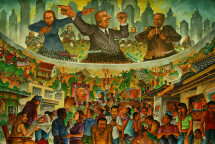Ideas into movement
Boost TNI's work
50 years. Hundreds of social struggles. Countless ideas turned into movement.
Support us as we celebrate our 50th anniversary in 2024.

Could the struggle against Israeli occupation within this rural vantage on the Middle East offer new insights into the emancipatory potential of agrarian and land-based political movements?

At an altitude of 1200 metres, the Golan Heights connect Syria, Lebanon, and Israel. The rural and mountainous landscape is verdant and fertile, internationally renowned for the excellent quality of its apples, cherries and vines. It has a rich supply of freshwater and recently discovered reserves of oil and gas. But the Golan Heights is also a place of occupation, protracted conflict, and resistance. Occupied by Israel since the 1967 war, the Golan Heights were illegally and unilaterally annexed to Israel in 1981. The Israeli occupation displaced, forcefully transferred and affected a total Syrian population of 126,879, destroying 340 villages and farms. Today, only five Syrian villages remain in the Golan Heights, with a population of 24,505. The remaining Syrian population has repeatedly denied ‘offers’ of Israeli citizenship and are internationally recognised as stateless, they have no passports but ‘travel documents’ and, in these documents, nationality is ‘undefined. ’
Although prior to the occupation the Golan Heights were home to a multi-ethnic and multi-religious mixture of Syrians (Mara’i and Halabi 1992), most of the stateless Syrians living there today belong to the Druze faith. Dispersed in the Levant, the Druze are an esoteric, endogamous, and non-proselytising religious community (Kastrinou, 2016). With historical roots dating to the 11th century Ismaili branch of Shia Islam, they are estimated to be a million people worldwide, mainly in Syria, Lebanon, Jordan and Israel. Their strong religious adherence, however, does not translate into transnational uniformity in their political affiliations. On the contrary, the Druze are valorised as nationalists within their respective nation-states: for example, as leaders of the nationalist Syrian revolt against the French Mandate in 1925, as the only Arabs ‘ to be trusted’ and to serve in the Israeli army, and as the ‘ kingmakers ’ in the confessional politics of Lebanon. Yet, at a time where the war in Syria is reinforcing religious and sectarian identities across the Middle East, the stateless Syrian Druze of the Golan Heights find themselves between their identities as Syrian and as Druze. As al-Nusra dominated rebel forces control the Syrian borderland, and as Israeli intervention in both Syria and in the Golan is becoming increasingly aggressive, the future of the native stateless Syrian Druze of the Occupied Golan Heights (hereinafter, SDOGH) looks increasingly uncertain.
Whilst the Israeli occupation has involved wholesale dispossession of Syrians from their land, including forced evictions and ethnic cleansing (Gordon and Ram 2016), as well as settlement programmes and acquisition of resources (such as freshwater and common land pastures), Israel has also used a very particular idea of the land, and the Golan landscape as part of its appropriation of the Golan Heights. That landscape idea represents the Golan Heights as Israel’s amazing ‘ wild west,’ a land of remarkable natural beauty, steeped in history, in need of protection and home to Israel’s only ski resort. Currently, the Golan Heights is home to 22,204 Israelis in 34 settlements. Moreover, Israel has used sectarian propaganda in order to weaken the national resistance movement among the occupied Syrians. As the stateless Syrians are predominantly members of the Druze religious community, Israel has continuously ‘played the sectarian card’: to impose a particularist sectarian identity as a way of obliterating Syrian and Arab nationalism in among the occupied population. While this strategy had been relatively successful among the Israeli Druze population (Firro 1999; Kananeh 2008), it has backfired in relation to the SDOGH, who continue to defy Israeli occupation and the sectarianisation of their identity. Could the struggle against Israeli occupation within this rural vantage on the Middle East offer new insights into the emancipatory potential of agrarian and land-based political movements?
With recourse to history and ethnography, we address the above question by exploring how and why the SDOGH stayed and resisted the occupation and subsequently chose to remain stateless. By way of explanation, we argue for a unique combination of 1) historical circumstance, 2) an economic - political - religious - cultural value in and attachment to the land, and 3) the simultaneous condition of being stateless and territorially rooted. These three factors help us understand how the SDOGH do not fit the current mould of a rural populace that is easily swayed by authoritarian populism. Neither do they fit the mould of ‘ statelessness ’ as a ‘condition of infinite danger’ (Walzer 1983, cited in Neocleous 2003: 109). This understanding allows us to see why the SDOGH, on the contrary, have an emancipatory positioning vis-a-vis the states of both Israel and Syria. Throughout the paper we illustrate how the SDOGH are able to mobilise a counter-hegemonic narrative by virtue of the legitimacy their intimate relation to the land affords them.
Firstly, we provide a brief note on research methodology. Secondly, we set out the theoretical premises of our paper, namely that sectarian identity politics in the Middle East can and should be looked at through the lens of the current conjuncture of authoritarian populism. This allows us to pay special attention to the local context of the Syrian war and the emboldening of right wing politics in Israel, but also to interrogate sectarian propaganda as part of a global authoritarian narrative structure. Thirdly, we provide an in-depth analysis of the material and ideational struggles over land and landscape in the Golan Heights. We conclude by discussing how both attachment to the land as well as the condition of statelessness have afforded the native Syrians a vantage point to resist and emancipate and what lessons this may offer for rural political struggles in the Middle East and beyond.